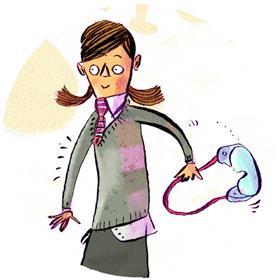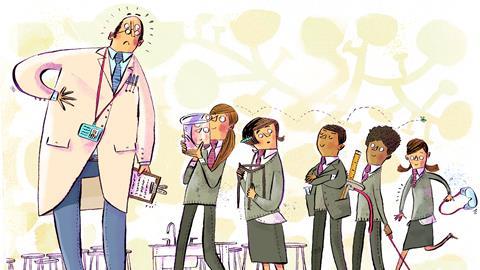Andy Chandler-Grevatt shares four solid strategies to help you establish expectations and routines for your classroom
As part of my job of training science teachers, I have the privilege of watching them teach lessons early on in their teaching and then again towards the end of the course, when they have gained some experience. The difference I experience when sitting in their classroom at this later stage is often based on the teacher having established learning behaviours with their classes, and having moved from reactive to proactive behaviour management. Being proactive in establishing learning behaviours is Recommendation 2 of the EEF Improving behaviour in schools guidance report; here, I discuss four stategies specific to science teaching.
Laying the foundations
Over the years, I have observed four proactive strategies that are effective in managing behaviour when teaching in a science laboratory. All of these have three foundations:
1. The teacher has explicitly shared the expectation with their pupils verbally, and sometimes in written form (on the board or on a poster).
2. The teacher has reinforced the expectation through praise and appropriate reprimand, narrating the reasons to their pupils.
3. The teacher is consistent in their expectations, based on the department or whole school behaviour policy.
1. Share basic expectations

When you meet a new class for the first time, including for cover, explain your expectations to the students. I keep it very simple: ‘Hello, I’m Dr Chandler-Grevatt. I am looking forward to teaching you science. So that I can do that, I expect you all to behave in a way that allows me to teach, and allows you all to learn. I will not tolerate behaviours that prevent me from teaching, or you or others from learning.’
The expectation has to be maintained and reinforced through example, praise and reprimand
Different teachers have different approaches. Whatever the approach, sharing expectations with your class sets the tone. However, the expectation has to be maintained and reinforced through example, praise and reprimand.
2. Manage and divert lab distractions

Working in a science laboratory presents unique distractions. Desks often have power sockets, gas taps and water taps within easy reach. These are very tempting to fiddle with while sat at the desk.
Tell your pupils explicitly what your expectations are from the start, for example: ‘You are working in a laboratory, so there are things around you that may be tempting to touch. Please do not touch the plug sockets, the gas taps or water taps near you unless you have been asked to use them. Fiddling with them can be dangerous (electricity or gas leak) and you may damage them, preventing us from doing practical work.’
Some schools have covers over these distractions that can reduce the temptation. For those pupils who really cannot overcome the urge, move them to a space where the temptation is removed.
3. Establish transitions
You can reduce the opportunity for distractions and misbehaviour by establishing clear routines for transitions between activities.

An essential transition is from chatter to silence. It’s important that you explain, practise and then reinforce this routine. To do so, you can apply the method of instruction, pause, scan, (reprimand), praise. For example, start with: ‘Year 9, put your pens down, stop talking and face this way.’ Pause. Scan. ‘Thank you, just waiting for Mike to put his pen down.’ Scan. ‘Libby, face this way.’ Pause when everyone is complying. ‘Well done, you all have your pens down, are not talking and are facing this way.’
Narrated countdowns can also work: ‘Silence and sat in 3 … Fatima, put that in the tray and sit … 2 … just waiting for the last two people to sit … and 1 … silence. Well done.’
Students [must] learn that, in an emergency, they need to stop practical work safely
When you want students to move from their normal seating spaces to another arrangement to see a demonstration, you can break this down to focus on each row or table of pupils moving from one position to another. As this is done more frequently, it can become quicker and require just a single instruction. ‘Move quickly and quietly into your spaces for a demo.’

4. Set routines for safe practical work
You may find it useful to establish routines for collecting and returning equipment to ensure safe and efficient practical work. You can start with establishing specific collection points and assign pupils responsibility for collecting and returning the equipment.
It is also worth rehearsing a ‘stop safely’ routine, where students learn that, in an emergency, they need to stop practical work safely. For example, just stopping can sometimes be hazardous in itself, so turning off a Bunsen burner and then standing still is safer.
When you have made your expectations clear and taught appropriate behaviour for learning in the laboratory, pupils will usually use these routines. When they do not, it will be no surprise to them if reprimands and consequences of misbehaviour are applied.
Looking for more?
Then you need to read Kristy Turner’s humorous take on managing behaviour in the chemistry lab and glean from Niki Kaiser’s ideas on how to improve outcomes by getting to know your pupils better. Or you could read David Paterson’s key strategies to help you support good classroom behaviour.

Behaviour management in the chemistry classroom

Overcome the challenges of misbehaviour in your lab with these targeted tips and strategies
- 1
- 2
- 3
- 4
 Currently
reading
Currently
reading
Set the scene for good behaviour in your lab
- 6
- 7
- 8





























1 Reader's comment